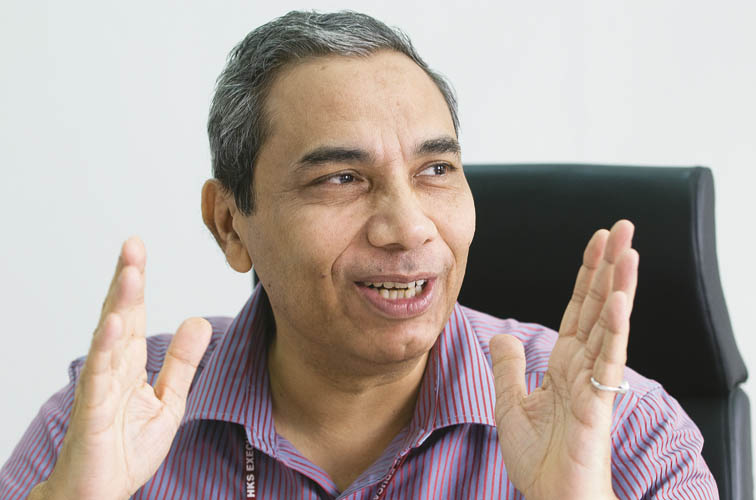
'If We Manage Financial Closure I must Do a Ganga Snan'
Gautam Chatterjee, in charge of redeveloping Mumbai's Dharavi slum, talks to Forbes India as the much-delayed bidding process draws to a close
Name: Gautam Chatterjee
Age: 53
Career: Chatterjee was the first director of the Prime Minister's Grant Project (PMGP) which spent Rs.100 crore for housing projects in Dharavi in the 1980s, and later headed the Slum Rehablitation Authority (SRA) in Mumbai for three years
Education: Gold Medalist in Msc from Patna University in 1978; IAS in 1982
Interests: Ranji Trophy cricket player from Patna and is an avid musician and singer
With so many slum developments in Mumbai, why is Dharavi so special?
Dharavi redevelopment has been conceptualised to be a path breaking initiative by the government on how to deal with in-city rehabilitation, and what better than to do it in an informal settlement of this size which is known as the biggest slum in Asia, which is not merely a slum, it is a city within a city. It is really an industrial, commercial hub with close to may be $1.5 billion turnover per year. Eighty percent of the residents draw their livelihood from within Dharavi. So when we refer to Dharavi redevelopment we have to be clear on the particular characteristics of this city called a slum.
Why have past attempts to remake Dharavi failed and why do you think this one will succeed?
In the past the thinking — even worldwide — with regard to rehabilitating informal settlements was, it comes down to security of tenure issue. But in Dharavi, people came up and said security of tenure was not an issue for them because a decade after the Slum Act came into effect in 1971, the government had already issued photo passes to the residents as a security of tenure. Those passes entitled them to continue staying where they were and if the government needed the land for any development projects, they were entitled to alternate accommodation. So the Dharavi residents were looking for something more. The aspiration of these people has always been that they have to be mainstreamed. They are looked down upon as slum dwellers — but formal housing will mean removal of that label.
Why is Dharavi being developed as a township instead of in parts?
You are talking about 60,000 hutments and 500,000 people in this settlement. There is no good infrastructure like water supply and neither housing nor amenities likes schools, hospitals etc. How do you provide all of this? [You can do that] only when you deal with this as a cluster development — the whole of Dharavi, one big planning unit which is subdivided into five smaller planning units.
What are the key challenges for a redevelopment project of this size and complexity?
First you work out how you integrate this city of Dharavi into the main city. So not only do you have to bring the individual slum dweller to the status of formal resident of the city but also bring the whole neighbourhood and make it a part of Mumbai.
When you bring all of this into the formal network, you require all the levels of infrastructure — roads, water supply, sewage.
Most important, Dharavi Is not merely a slum — there are livelihood issues. What happens to their industrial commercial activities, many of which take place inside their homes and are not documented? These have to be adjusted inside commercial structures — but will these activities continue when you put them inside a multi-storey building? That was the real challenge.
As the CEO, are you then in a perpetual hot seat?
You have high density issues, you are facing challenges of ecological sustainability and issues of integration. You have issues of livelihood which have to be restored and further improved upon and there should be no loss of livelihood. And there is no budgetary support for your high rise and high-cost development. You are trying to use concept of land as a resource, you are trying to woo private developers to put in money for this high cost development — they will not do it for charity, they will also look for returns.
It has taken a very long period and still, let me admit, we have not been able to bring all the stakeholders on board and to agree that yes, this is the right path. And Dharavi has so many peculiarities different from any slum. It’s a city within a city, it’s an industrial hub and generates so much employment — will your type of development destroy the livelihoods there? We feel that ultimately the decision will have to be in consultation with the people. So we speak to the people’s representatives, but very often the representatives aren’t saying what the people want. There are also political leanings, especially when you are dealing with the subject in a year with back to back elections.
There has been a lot of opposition to this project. How have you managed to address it?
In early 2008 when the bidding process began, the opposition was because stakeholders felt the discussions were still not complete. Later the opposition was because people wanted larger houses and a bigger corpus because they would have to move to high-rises where the maintenance costs are more.
On the size issue, we said in a general SRA scheme the size is 269 sq feet, but in Dharavi where we have taken away their right to appoint a developer, since we are giving them better amenities, let us also give them a little more and, so now, it’s 300 sq feet house.
We increased corpus from Rs. 20,000 per tenement to Rs. 40,000 and we said for 15 years after the buildings come up, operations and maintenance will be looked after by the developer’s representatives, so you’re outgoings will be minimised.
If we manage to do financial closure I think I must do a ganga snan [a dip in the Ganges as thanksgiving]! For the financial bids we wanted a level playing field, so we started creating a standardised master plan for the developers, which will be binding on them. When ultimately five of these bidders are selected, they each have to have a community development team which will work with the communities. Then the developers will show their plans and ideas to the communities and seek their approval and sign agreements with them and then finally the plans will be approved by the rehabilitation authorities.
Has there been huge political pressure on you because this is an election year?
Well, political pressure is not the right word but yes, this is an election year and there have been certain political intonations to the project and its progress. Government has its compulsions; the local MLA feels, how long can I keep telling my people this project is coming? There is huge eagerness for financial closure. FSI, for one, has been something debated about — the politicians might say 400 sq feet but they need to understand that if you say 400 sq feet, the project will never take off. So there is definitely this issue of wanting to set the right precedent, because whatever you do here is likely to be replicated elsewhere. Ultimately, politicians feel the pulse of the people and if majority of people feel 300 sq feet is great for them then I’m sure everyone will fall in line.
(This story appears in the 14 August, 2009 issue of Forbes India. To visit our Archives, click here.)















